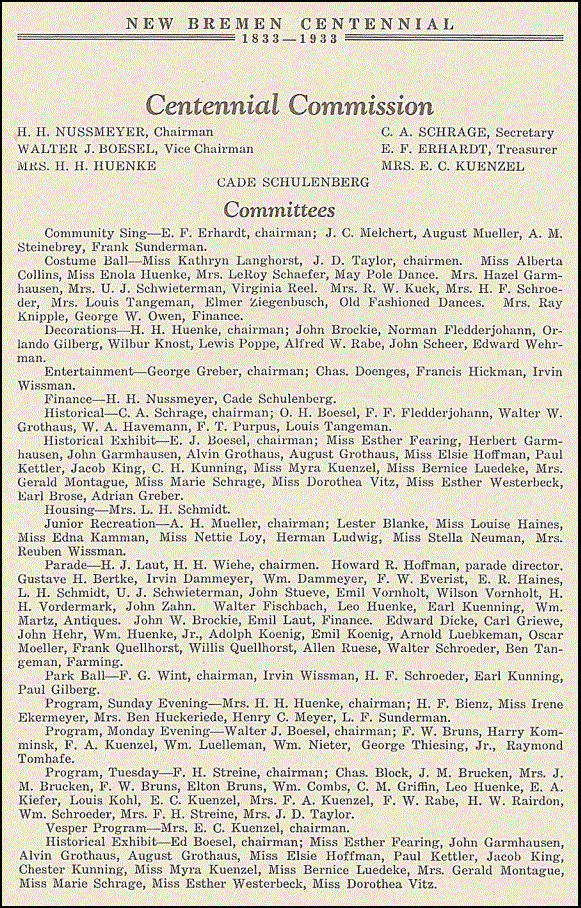No products
New Bremen Centennial Book - 1933
Excerpts from Walter W. Grothaus’s Chronology – Pgs. 32-34
[*additional notes by Johanna Schroer & Lucille Francis]
1832
Company of Germans organized in Cincinnati for the purpose of locating a town to be colonized by German Protestants. Ten acres were purchased from the government at one dollar per acre.
1833
Town named “Bremen” and recorded in Mercer County on June 11, 1833. First settlers arrived. First log house built, 12x14 feet. Land purchased in adjacent countryside at $1.25 per acre. Combined school and church built at cost of $40.00
1835
First post office opened. Name of town changed from “Bremen” to New Bremen”.
1837
New Bremen incorporated under provisions of H.B. No. 374, Ohio Legislature. Passed March 23, 1837. Settlers obtained employment in building of Miami and Erie Canal.
1840
First town election. Officers named were: G. Klefoth, mayor; C. Boesel, recorder; G.M. Epperson, F.F. Boesche, F. Maurer, council.
1846
Oldest official town records obtainable show Friederich Schulenberg, recorder; Wm. A. Haveman, J.H. Knost, Wm. Witte, F. Wehrman, B. Wellman, G. Klefoth, town council.
1847
German Township, comprising what is now German and Jackson Townships, was divided into a north and south election precinct by act of the General Assembly. German Township originally belonged to Shelby County, but sometime after its settlement became a part of Mercer County.
1848*
Auglaize County established from Mercer County as Ohio’s 84th of 88 Counties.
1849*
Wapakoneta becomes the Auglaize County seat to the chagrin of St. Marys.
1850*
In 1850, there were five hotels in New Bremen: the Lehmkuhl, Meyer, Wilhelmy/Wilhelmi, Minkner, and the Lanfersieck House. There were ten saloons and six dance halls. The 1850 Federal census lists a variety of occupations including brick mason, butcher, clerk, (wooden) shoemaker, boat captain, teacher, miller, and a physician. Businesses listed included ten cooperages, six shoemaker shops, six blacksmith shops, a carriage shop, several pork-packing houses, and a half dozen canal boats, employing six men each. The census indicates 302 local farmers.
1852
Minutes of the council were kept in German from 1852 to 1866.
1858
German Township divided into German and Jackson Townships.
1866
Council records of 1866: “Any person or persons burying any person or persons on the burying ground within the limits of the corporation of New Bremen shall be fined in the sum not exceeding fifty dollars nor less than twenty five dollars.” [*This was after burying was banned within the village of New Bremen, and the German Protestant and Willow Grove Cemeteries were established.]
On January 19, 1866, the contract was awarded for the building of the West Side Engine House (*North Main Street Fire Station) to Henry Brinkmeyer, carpenter work; C. Langhorst, masonry work.
1875
On October 12, 1875, an election was held to decide whether or not to annex Ober Bremen to the Incorporated Village of New Bremen. By a vote of 101 to 16, it passed and was annexed the following year.
1876*
New Bremen officially united six communities: Bremen's 1833 original plat (west of canal), 1837 Amsterdam (lost to cholera in 1849), 1838 Mohrmansville (north of New Bremen), 1853 Ober Bremen (east of the canal), 1856 Vogelsangtown (west of canal and south of New Bremen), 1859 Lock Two (formerly New Paris).
1884
L. Dorfer was named the first Chief of the combined Fire Departments of New Bremen.
1888
On July 3, 1888, for the first time, New Bremen had the pleasure of witnessing the burning flame of natural gas. The streets were lined with a solid mass of people to witness the occasion. There was a deafening roar of the gas, booming of the cannon, cheering of the people, beating of muffled drums and cracking of firecrackers.
1893
On December 20, 1893, Reliance Machine & Tool Co. of Cleveland was granted permission to use the streets and alleys to install electric light equipment.
1896
On January 3, 1896, the Boesel Opera House opened.
1897
On January 2, 1897, the St. Paul Church was destroyed by fire. The Washington Street Engine House (fire department) was dedicated August 7th . Council granted use of streets and alleys for telephone lines.
1898
On April 28, 1898, volunteers left for service in the Spanish-American War.
1900
A franchise was granted to the Western Ohio Railway (interurban) to build through the streets of New Bremen.
1902
New Bremen built its electric light and water works.
1906
The first street paving in New Bremen was done by Heffner & Son.
1909
On June 17, 1909, two people were killed as the Western Ohio (interurban) car left the rails at the corner of Main and Monroe Streets and turned on its side.
1911
The sewage disposal plant was built.
1917
On September 21, 1917, during the First World War, a contingent of men left for Camp Sherman.
1927
The Fire Department received its first motorized vehicle.
1930
On February 7, 1930, the new New Bremen High School on South Walnut Street was dedicated.
1931
The Western Ohio Railway (interurban) was abandoned and the tracks were removed.
1933*
On July 1-4, 1933, New Bremen celebrated its 100th birthday and the book “New Bremen Centennial 1833-1933” was published. The following is page 3 from the book which lists the names of the people who were in charge of the celebration.


